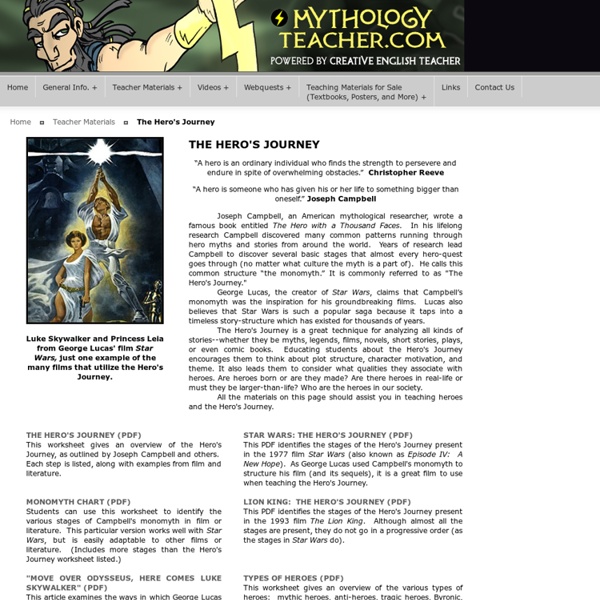MythologyTeacher.com
“A hero is an ordinary individual who finds the strength to persevere and endure in spite of overwhelming obstacles.” Christopher Reeve “A hero is someone who has given his or her life to something bigger than oneself.” Joseph Campbell Joseph Campbell, an American mythological researcher, wrote a famous book entitled The Hero with a Thousand Faces. George Lucas, the creator of Star Wars, claims that Campbell’s monomyth was the inspiration for his groundbreaking films. The Hero's Journey is a great technique for analyzing all kinds of stories--whether they be myths, legends, films, novels, short stories, plays, or even comic books. All the materials on this page should assist you in teaching heroes and the Hero's Journey.
Heroes Are Made of This: Studying the Character of Heroes
ReadWriteThink couldn't publish all of this great content without literacy experts to write and review for us. If you've got lessons plans, activities, or other ideas you'd like to contribute, we'd love to hear from you. More Find the latest in professional publications, learn new techniques and strategies, and find out how you can connect with other literacy professionals. More Teacher Resources by Grade Your students can save their work with Student Interactives. More Home › Classroom Resources › Lesson Plans Lesson Plan Overview Featured Resources From Theory to Practice Designed to explore the hero and the heroic in literature, this sequence of activities can be used as a unit or as stand-alone activities. back to top Hero's Traits Reader's Log: Have students use this reproducible to track character traits as they read. Further Reading Moon, Brian. 2000. This lesson is based in part on: Rodrigues, Raymond J., and Dennis Badaczewski. 1978.
The Hero's Quest
|Arthurian Legend| |Beowulf| |Classical Mythology| |Creation Stories| |Fairy Tales and Folktales| |Homer, The Iliad and The Odyssey| |Mythology Main Page| The all-purpose guide to epic moviesThis chart shows different archetypal roles at work in Harry Potter, Star Wars, and other movies: the hero, the threshold guardian, the trickster, etc. An Anti-Hero of One's OwnThis TED-ED video (4:11) explores the pattern of the anti-hero using references to Fahrenheit 451 and 1984, among others. Captioned, includes follow-up questions and other support. ArchetypesThis Google Doc lists and describes types of heroes, quests, stages, characteristics, and symbols. Students are invited to find examples. Chart of GodsThis printable handout details the Greek and Roman gods and goddesses, their spheres of influence, symbols, cities, and animals. Comparison of World MythsThis page outlines similarities and differences in world myths. The Hero's JourneyDetailed resource of the elements of the hero's journey.
Encyclopedia of Myths
Related:
Related:



